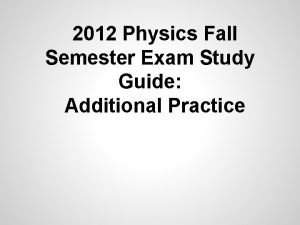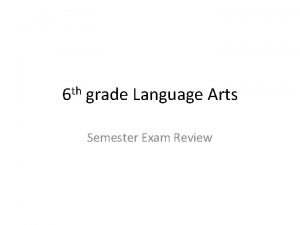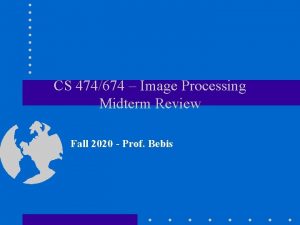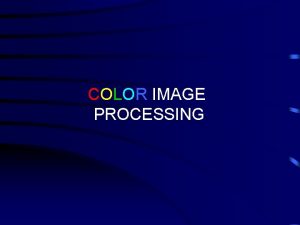CS 474674 Image Processing Final Exam Review Fall













- Slides: 13

CS 474/674 – Image Processing Final Exam Review Fall 2019 - Prof. Bebis

Final Exam • When: 12/16/2019, 9: 50 am – 11: 50 am (same room) • What: comprehensive • Closed-books, closed-notes – True/False questions, 1 -2 proofs, and problems similar to the ones you have seen in class and the homework. – Study very well all the examples we did in class, quizzes, homework, and sample exams. • Bring a calculator (no smart phones!) • Be familiar with common equations (e. g. , FT, convolution, etc. ) - no need to memorize long/complicated formulas (e. g. , motion blur formula) – they will be provided to you if needed.

Final Exam Topics (comprehensive) 1. Midterm Exam material 2. Frequency Filtering 3. Image Restoration 4. Image Compression 5. Short-time Fourier Transform

Frequency Filtering • Low-pass, high-pass, and band-pass filters – Explain both in time and frequency domains • How is a filter specified in the frequency domain? – Specify in the time domain, then take FT (preserve symmetries!) – Specify directly in the frequency domain (sample correctly!) • What are the main steps of filtering in the frequency domain? • Why does low-pass filters cause blurring? – Explain both in time/frequency domains

Frequency Filtering (cont’d) • What is the “ringing” effect? – How can it be avoided? • Explain high emphasis filtering using frequency domain analysis. • What is homomorphic filtering? – What are the main assumptions? – When should one use it? – What are the main steps?

Image Restoration • What is the goal of image restoration? – How is it different from image enhancement techniques? • Degradation model under the assumptions of linearity and shift invariance – How do we model it? – Graduate Students Only: need to know the proof. • Noise models (probabilistic) – How could we estimate the model parameters? • Noise removal filters – mean, order statistics, adaptive, frequency domain

Image Restoration (cont’d) • Modeling the degradation function (e. g. , atmospheric turbulence, camera motion) – Graduate Students Only: need to know how to derive the degradation function in the case of motion blur. • Inverse filtering – How does it work? – Main assumptions? – Practical problems and ways to address them.

Image Restoration (cont’d) • Wiener filtering – – How does it work? Assumptions? How does it compare to inverse filtering? Practical problems and ways to address them. • Least Squares Constrained (LSC) filtering – – How does it work? Assumptions? How does it compares to Wiener filtering? What is its main advantage?

Image Compression • • What is the goal image compression? Lossless vs lossy compression Compression ratio, data redundancy, Data ≠ information Types of data redundancy – How can we deal with coding redundancy? (e. g. , variable length coding) – How can we deal with interpixel redundancy? (e. g. , mapping) – How can we deal with psychovisual redundancy? (e. g. , quantization)

Image Compression (cont’d) • How do we modeling the information generation process? – Probabilistically - explain • How do we measuring information? – Entropy - explain • Computing redundancy (i. e. , using entropy information). • Different order estimates of entropy and their importance. • Main components of image compression (i. e. , encoder, decoder). • Fidelity criteria (i. e. , subjective, objective)

Image Compression (cont’d) • Main components of encoders (i. e. , mapper, quantizer, symbol encoder) and decoders (i. e. , inverse steps) • Lossless compression – Huffman, Arithmetic, LZW, Run Length, Bit-plane • Lossy compression – Examples of mappers (i. e. , FT, DCT, WT) – What is the key property of a "good" mapper?

Image Compression (cont’d) • JPEG compression – What are the steps? – Understand each step and its purpose very well! • Different modes of JPEG – know what they are and what they do. – – Progressive spectral selection algorithm Progressive successive approximation algorithm Hybrid algorithm Hierarchical

Short-time Fourier Transform • Limitations of Fourier Transform – Lack of simultaneous time-frequency localization – explain. – Not useful for analyzing non-stationary signals – explain. – Not efficient in handling discontinuities – explain. • Short Time Fourier Transform (STFT) – What is the main idea? – How does it address the issue of simultaneous time-frequency localization? • Practical issues – Window function, window shape, window width. – Heisenberg (or Uncertainty) principle - explain
 Physics 20 final exam practice
Physics 20 final exam practice Ap gov review final exam review
Ap gov review final exam review Us history semester 1 final exam study guide answers
Us history semester 1 final exam study guide answers Physics fall semester review answers
Physics fall semester review answers Fall semester exam review us history
Fall semester exam review us history English 3 fall semester exam review
English 3 fall semester exam review English 11 semester exam
English 11 semester exam World history regular semester 1 review
World history regular semester 1 review World history spring final exam review answers
World history spring final exam review answers Spanish final exam review packet answer key
Spanish final exam review packet answer key Human body systems final exam
Human body systems final exam Poe practice test kinematics answers
Poe practice test kinematics answers Ied final exam
Ied final exam Principles of business final exam answer key
Principles of business final exam answer key
























